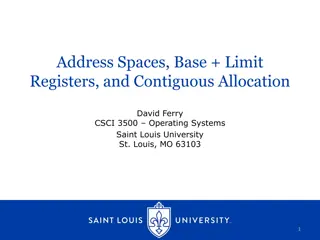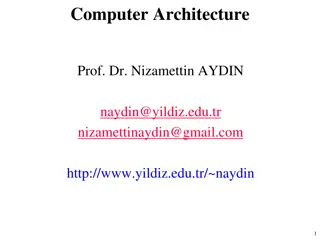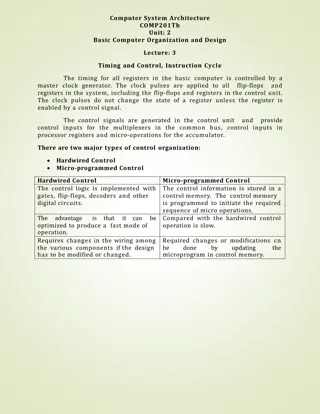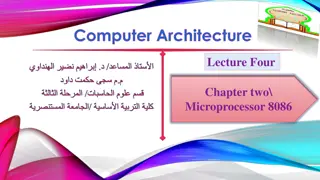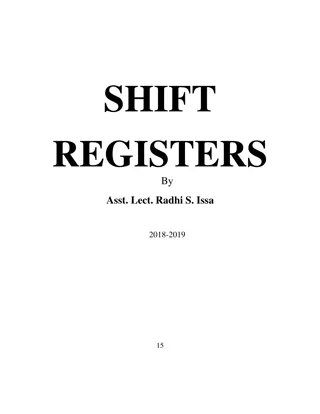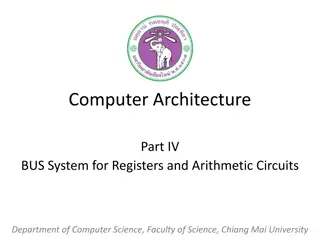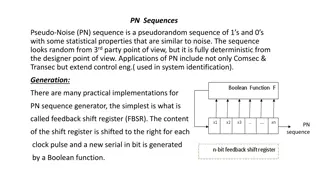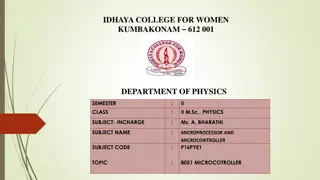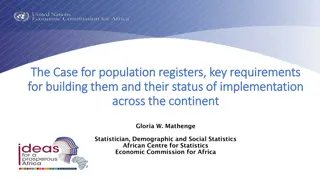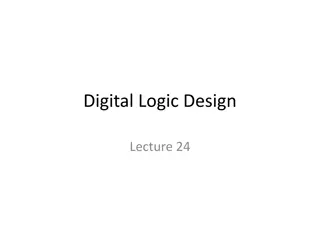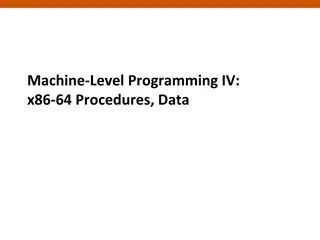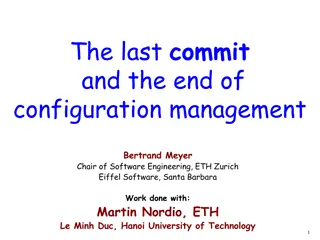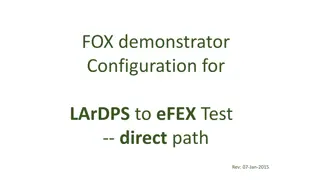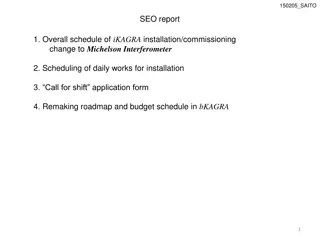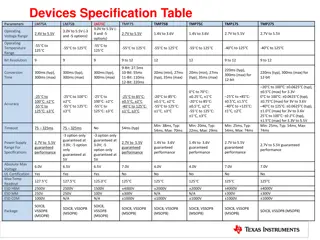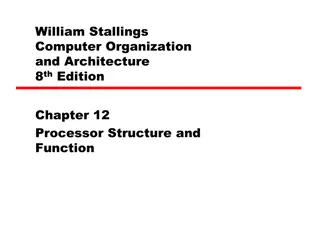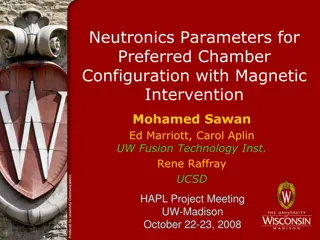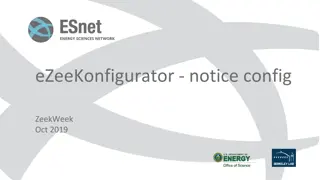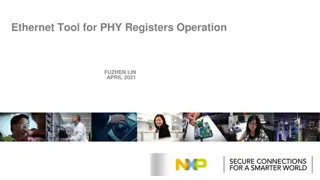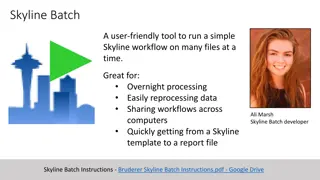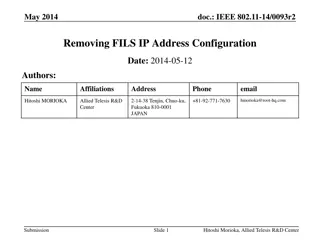ANALOG AND DIGITAL ELECTRONICS 21CS33
Explore the world of analog and digital electronics through the lens of registers, counters, and flip-flops. Dive deep into the operation of these components, learn how to transfer data between registers, build and analyze shift registers, construct timing diagrams, and understand binary counters. D
0 views • 112 slides
WHONET Training Course: Laboratory Configuration and Setup
Understanding the laboratory configuration process in WHONET is crucial for effective data entry and analysis. This module guides users on setting up a new laboratory, entering country and lab details, defining antibiotics, sample locations, and data fields, creating microbiological alerts, and savi
3 views • 57 slides
COMPUTER ORGANISATION Register Transfer Language
Register Transfer Language is a symbolic notation used to describe the micro-operations transferring data among registers in computer organisation. It signifies the availability of hardware logic circuits to perform specified micro-operations and transfer results between registers. Register Transfer
6 views • 7 slides
Implementing Address Spaces: Base + Limit Registers
Address spaces, base + limit registers, and contiguous allocation are essential concepts in operating systems. Real mode memory addresses lack isolation between processes and pose limitations on multitasking. Virtual memory introduces virtual address spaces, requiring translation to physical address
3 views • 11 slides
Understanding Computer Architecture: CPU Structure and Function
Delve into the intricate world of computer architecture with Prof. Dr. Nizamettin AYDIN as your guide. Explore topics such as CPU structure, registers, instruction cycles, data flow, pipelining, and handling conditional branches. Gain insights into the responsibilities of a CPU, internal structures,
0 views • 39 slides
Understanding Basic Input/Output Operations in Computer Organization
Basic Input/Output Operations are essential functions in computer systems that involve transferring data between processors and external devices like keyboards and displays. This task requires synchronization mechanisms due to differences in processing speeds. The process involves reading characters
0 views • 11 slides
Introduction to Intel Assembly Language for x86 Processors
Intel Assembly Language is a low-level programming language designed for Intel 8086 processors and their successors. It features a CISC instruction set, special purpose registers, memory-register operations, and various addressing modes. The language employs mnemonics to represent instructions, with
2 views • 12 slides
Basic Computer Organization and Design - Timing and Control
The timing of all registers in a basic computer is governed by a master clock generator, with clock pulses controlling the flip-flops and registers in the system. Two main types of control organization are Hardwired Control and Micro-programmed Control. The former uses digital circuitry like gates a
1 views • 4 slides
Understanding Flag Registers in Microprocessor 8086
This content discusses the flag registers in the Microprocessor 8086, covering conditional flags such as Carry Flag (CF), Auxiliary Flag (AF), Parity Flag (PF), Zero Flag (ZF), Sign Flag (SF), and Overflow Flag (OF), as well as control flags including Trap Flag (TP), Interrupt Flag (IF), and Directi
1 views • 23 slides
Overview of MIPS Arithmetic and Logic Instructions in COE 301
MIPS Architecture consists of R-Type and I-Type instruction formats for arithmetic, logical, shift, and immediate constant operations. It includes a variety of general-purpose registers and specific units for execution, floating-point operations, and memory handling. The presentation outlines the st
2 views • 29 slides
Understanding Shift Registers in Digital Electronics
Shift registers are a fundamental concept in digital electronics where binary numbers are shifted from one flip-flop to the next. They come in various types like SISO, SIPO, PISO, and PIPO, serving different purposes such as delay lines, data converters, sequential memory, and ring counters. The ope
0 views • 10 slides
Understanding BUS Systems in Computer Architecture
This article explores the concept of BUS systems in computer architecture, focusing on the efficient transfer of information between registers using a common bus structure. It delves into the implementation of bus systems for multiple-register configurations, such as a bus system for four registers
0 views • 24 slides
Understanding Pseudo-Noise Sequences and Applications
Pseudo-Noise (PN) sequences are deterministic yet appear random, with applications in various fields such as communication security, control engineering, and system identification. Generated using shift registers, they exhibit statistical properties akin to noise. Linear and nonlinear feedback shift
1 views • 19 slides
Director ID Trust Deed Webinar - Modernising Business Registers Program Update
Director ID Trust Deed webinar on 7th December 2021 introduces the Director Identification Number (director ID) initiative to enhance trust and transparency in business registrations. The program aims to modernize business registers, streamline registration processes, and improve data accuracy, maki
0 views • 21 slides
Understanding the 8051 Microcontroller: Features, Registers, and Applications
A detailed overview of the 8051 microcontroller including its introduction, features, and registers. Explore how the 8051 is useful for small computing tasks, control applications, and its low power consumption. Learn about the various registers in the 8051 such as the accumulator, program counter,
0 views • 18 slides
Enhancing EPS Authorization and Configuration Options in 5G Networks
The proposal focuses on enhancing authorization and configuration options in EPS using protocol configuration options. It discusses the attach procedure, ePCO checking, and the importance of ePCO support in the network architecture. The solution presented emphasizes the role of MME, SGW, and PGW-C+S
0 views • 8 slides
The Case for Population Registers: Key Requirements and Implementation Status Across Africa
Population registers play a crucial role in providing robust and timely population data, especially in the current era emphasizing rigorous measurement and monitoring of human development. Implementing e-government platforms and facing challenges like the Covid-19 pandemic have highlighted the impor
0 views • 18 slides
Challenges in Transition from Primary to Secondary School: Corpus Design
The linguistic challenges in transitioning from primary to secondary school in England are explored in this project. The focus is on academic school language and the barriers students face in understanding the curriculum, particularly at the start of Key Stage 3. The differing registers of academic
0 views • 28 slides
Overview of 8086 Assembly Language Arithmetic Operations
The 8086 assembly language provides instructions for arithmetic operations such as addition, subtraction, and comparison. These operations are essential for manipulating data in memory and registers. The instructions support various operand types, including registers, memory locations, and immediate
0 views • 24 slides
Understanding Quality Dimensions in Statistical Business Registers
Quality in statistical business registers encompasses dimensions such as relevance, accuracy, timeliness, accessibility, comparability, and coherence. The United Nations provides guidance on quality frameworks for official statistics, emphasizing the importance of tailoring quality assurance policie
0 views • 28 slides
Understanding Shift Registers: Introduction and Classification
Explore the world of shift registers, including buffer registers, and different modes of operation like serial in/serial out, serial in/parallel out, parallel in/serial out, and parallel in/parallel out. Learn about the construction, operation, and classification of registers in digital systems.
1 views • 24 slides
Understanding Shift Registers in Sequential Logic Circuits
Shift registers are sequential logic circuits used for storing digital data. They consist of interconnected flip-flops that shift data in a controlled manner. This article explores different types of shift registers such as Serial In - Serial Out, Serial In - Parallel Out, Parallel In - Serial Out,
2 views • 9 slides
Digital Logic Design Lecture on Registers and Counters
In this lecture, we covered topics on Registers and Counters in digital logic design. Registers are used to hold information within a digital system, while Counters are utilized to produce specified output pattern sequences. Different types of registers such as shift registers were discussed along w
0 views • 25 slides
Understanding Branching and Condition Codes in Computer Architecture
Explore the intricacies of branching statements, if-else statements, condition codes, explicit compare and branch, implicit condition codes, and the use of condition registers in computer architecture. Delve into MIPS architecture's utilization of both implicit and condition registers for efficient
0 views • 16 slides
Understanding x86-64 Procedures and Data Structures
This content provides insights into x86-64 programming, covering topics such as procedures, integer registers, stack frames, locals in the red zone, interesting features of stack frames, arrays, multi-dimensional structures, and more. It dives into the usage conventions of integer registers, the all
0 views • 44 slides
Evolution of Configuration Management in Software Engineering
Explore the evolution of configuration management in software engineering, highlighting key practices like cloud-based IDE, shared repositories, and unobtrusive configuration management. Understand the importance of modern best practices in software development, traditional vs. optimistic approaches
0 views • 20 slides
Nordic Prescription Registers in Iceland: Overview and Coverage
The Nordic Prescription Registers in Iceland provide detailed data on prescription drug dispensing, covering variables such as drug user information, dispensing details, prescriber data, pharmacy information, and more. The database includes information on all reimbursed and non-reimbursed prescripti
0 views • 11 slides
LArDPS to eFEX Test Configuration for FOX Demonstrator
Configuration details and diagrams for testing the direct path from the LArDPS to eFEX in the FOX Demonstrator, including optical insertion loss measurements, offset calibration using different setups, and diagrams without splitters. The setup matches the planned configuration for the test.
0 views • 34 slides
Updates on iKAGRA Installation and Configuration Changes
The report discusses changes in the iKAGRA configuration from Fabry-Perot Michelson Interferometer to Michelson Interferometer due to schedule constraints and budget limitations. The document outlines the revised schedule for installation tasks, shift applications, and the impact on the KAGRA projec
0 views • 16 slides
Enhancing Out-of-Order Completion with In-Order Retirement
To improve performance, instructions are retired in dispatch order rather than completion order. Introduce appearance changes in architectural state, track oldest and newest instructions, and allow rollback to un-retired instructions. Implement reorder buffers, separate rename registers, and utilize
0 views • 5 slides
- "Temperature Sensor Devices Specifications and Register Configuration
- This comprehensive content provides detailed specifications and register mappings for various temperature sensor devices, including LM75A, LM75B, LM75C, TMP75, TMP75B, TMP75C, TMP175, and TMP275. It covers parameters such as operating voltage range, resolution, accuracy, operating temperature rang
0 views • 6 slides
Insights into Operating Experience and Configuration Management in Nuclear Power Plants
Explore the significance of Operating Experience (OE) in refining machine and human performance, reinforcing desired behaviors, solving problems timely, and sharing industry-wide knowledge in nuclear power. Learn from examples highlighting the importance of configuration management in mature nuclear
0 views • 11 slides
Understanding CPU Structure and Function in Computer Organization and Architecture
Exploring the intricate details of CPU architecture, this content delves into the essential tasks of fetching, interpreting, processing, and writing data. It discusses the significance of registers, user-visible registers, general-purpose registers, and condition code registers in CPU operations. Ad
0 views • 83 slides
Advanced Neutronics Parameters for Fusion Chamber Configuration with Magnetic Intervention
Detailed analysis and design considerations for a fusion chamber configuration utilizing magnetic intervention to optimize neutronics parameters. The discussion includes blanket configuration, neutron wall loading distribution, blanket design options, nuclear design requirements, and dimensions meet
0 views • 12 slides
Recap of eZeeKonfigurator Notice Configuration and Zeek Week Oct 2019
A summary of events involving a talk at Zeek Week, issues with notice configuration, experiences with Zeek/Bro, and the introduction of eZeeKonfigurator for configuring Zeek clusters. The content includes descriptions of individuals involved, challenges faced, support for cluster configurations, and
0 views • 20 slides
Ethernet PHY Registers Tool Operation
The Ethernet PHY Registers Tool provides a simple way to read and write PHY registers using MDC/MDIO, aiding in development and issue debugging. This tool requires the Ethernet PHY to be connected with MDIO/MDC and initialized in a Linux environment. Pre-built binaries and source code are provided f
0 views • 9 slides
Efficient Skyline Batch Workflow Tool for Processing Multiple Files
Utilize Skyline Batch, a user-friendly tool developed by Ali Marsh, to run simple Skyline workflows on multiple files efficiently. This tool is ideal for overnight processing, reprocessing data easily, and sharing workflows across different computers. Quickly transform Skyline templates into report
0 views • 4 slides
Understanding x64 Assembly Programming Essentials
Dive into the world of x64 assembly programming with a focus on registers, operands, addressing modes, and more. Explore key concepts such as bomb labs, GDB, Unix commands, and the importance of registers in hardware. Enhance your understanding of moving data between registers and memory while disse
0 views • 24 slides
Removal of FILS IP Address Configuration in IEEE 802.11-14/0093r2
This document details the rationale behind the proposal to remove FILS IP Address Configuration in IEEE 802.11-14/0093r2. The author, Hitoshi Morioka, explains that the need for this configuration is redundant due to the HLP encapsulation's ability to support all required functions. By eliminating c
0 views • 18 slides
Corporate Registers Forum - Empowering Global Registry Management
The Corporate Registers Forum (CRF) is an international organization dedicated to fostering collaboration among administrators of corporate registers worldwide. Established in 2006, the CRF aims to facilitate the exchange of information, address registration challenges, and promote efficient registr
0 views • 13 slides



